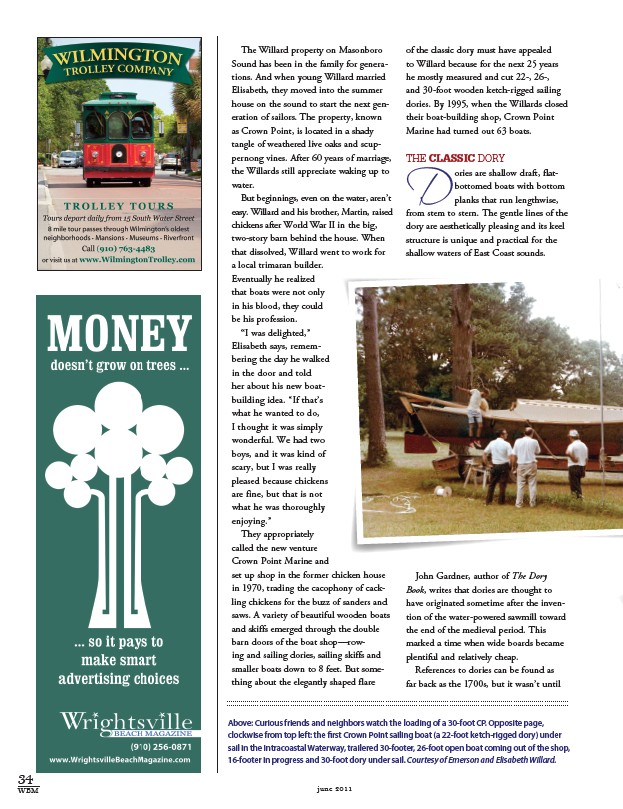
The Willard property on Masonboro
Sound has been in the family for generations.
And when young Willard married
Elisabeth, they moved into the summer
house on the sound to start the next generation
of sailors. The property, known
as Crown Point, is located in a shady
tangle of weathered live oaks and scuppernong
vines. After 60 years of marriage,
the Willards still appreciate waking up to
water.
But beginnings, even on the water, aren’t
easy. Willard and his brother, Martin, raised
chickens after World War II in the big,
two-story barn behind the house. When
that dissolved, Willard went to work for
a local trimaran builder.
Eventually he realized
that boats were not only
in his blood, they could
be his profession.
“I was delighted,”
Elisabeth says, remembering
the day he walked
in the door and told
her about his new boatbuilding
idea. “If that’s
what he wanted to do,
I thought it was simply
wonderful. We had two
boys, and it was kind of
scary, but I was really
pleased because chickens
are fine, but that is not
what he was thoroughly
enjoying.”
They appropriately
called the new venture
Crown Point Marine and
set up shop in the former chicken house
in 1970, trading the cacophony of cackling
chickens for the buzz of sanders and
saws. A variety of beautiful wooden boats
and skiffs emerged through the double
barn doors of the boat shop—rowing
and sailing dories, sailing skiffs and
smaller boats down to 8 feet. But something
about the elegantly shaped flare
34
WBM june 2011
of the classic dory must have appealed
to Willard because for the next 25 years
he mostly measured and cut 22-, 26-,
and 30-foot wooden ketch-rigged sailing
dories. By 1995, when the Willards closed
their boat-building shop, Crown Point
Marine had turned out 63 boats.
The Classic Dory Dories are shallow draft, flatbottomed
boats with bottom
planks that run lengthwise,
from stem to stern. The gentle lines of the
dory are aesthetically pleasing and its keel
structure is unique and practical for the
shallow waters of East Coast sounds.
John Gardner, author of The Dory
Book, writes that dories are thought to
have originated sometime after the invention
of the water-powered sawmill toward
the end of the medieval period. This
marked a time when wide boards became
plentiful and relatively cheap.
References to dories can be found as
far back as the 1700s, but it wasn’t until
Above: Curious friends and neighbors watch the loading of a 30-foot CP. Opposite page,
clockwise from top left: the first Crown Point sailing boat (a 22-foot ketch-rigged dory) under
sail in the Intracoastal Waterway, trailered 30-footer, 26-foot open boat coming out of the shop,
16-footer in progress and 30-foot dory under sail. Courtesy of Emerson and Elisabeth Willard.